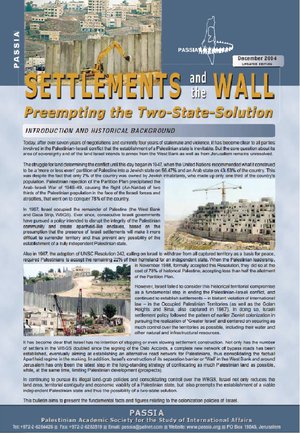Settlements and the Wall – Preempting the Two-State Solution - Special Bulletin
This Special Bulletin presents the basic facts and figures relating to the issue
of settlements – their number, their distribution, their population and their
growth rates – as well as the Wall Israel is currently building in the West
Bank. It looks at the historical background of settlements, their status in
international law and UN resolutions, and their role in the peace process.
Israeli options for a final status agreement as well as the Palestinian position
are explored. Furthermore examined are the background, legal aspects,
and implications of Israel’s Wall, its pro posed unilateral disengagement and
alternative road plan, as well as their impact on Palestinian lives. Eventually,
the bulletin explores the various Israeli options for a Palestinian state. The
text is illustrated with eight maps and several graphs and tables, and also
includes a list of further research sources on the topic.
Overview
Today, after over seven years of negotiations and currently four years of stalemate and violence, it has become clear to all parties involved in the Palestinian-Israeli conflict that the establishment of a Palestinian state is inevitable. But the core question about its area of sovereignty and of the land Israel intends to annex from the West Bank as well as from Jerusalem remains unresolved.
The struggle for land determining the conflict until this day began in 1947, when the United Nations recommended what it construed to be a ‘more or less even’ partition of Palestine into a Jewish state on 56.47% and an Arab state on 43.53% of the country. This was despite the fact that only 7% of the country was owned by Jewish inhabitants, who made up only one third of the country’s population. Palestinian rejection of the Partition Plan precipitated the Arab-Israeli War of 1948-49, causing the fight (An-Nakba) of two thirds of the Palestinian population in the face of the Israeli forces and atrocities, that went on to conquer 78% of the country. In 1967, Israel occupied the remainder of Palestine (the West Bank and Gaza Strip, WBGS). Ever since, consecutive Israeli governments have pursued a policy intended to disrupt the integrity of the Palestinian community and create apartheid-like enclaves, based on the presumption that the presence of Israeli settlements will make it more difficult to surrender territory and thus prevent any possibility of the establishment of a truly independent Palestinian state. Also in 1967, the adoption of UNSC Resolution 242, calling on Israel to withdraw from all captured territory as a basis for peace, required Palestinians to accept the remaining 22% of their homeland for an independent state. When the Palestinian leadership, in November 1988, formally accepted this Resolution, they did so at the cost of 78% of historical Palestine, accepting less than half the allotment of the Partition Plan. However, Israel failed to consider this historical territorial compromise as a fundamental step in ending the Palestinian-Israeli conflict, and continued to establish settlements – in blatant violation of international law – in the Occupied Palestinian Territories (as well as the Golan Heights and Sinai, also captured in 1967). In doing so, Israeli settlement policy followed the pattern of earlier Zionist colonization in pursuing the realization of ‘Greater Israel’ and centered on securing as much control over the territories as possible, including their water and other natural and infrastructural resources.
It has become clear that Israel has no intention of stopping or even slowing settlement construction. Not only has the number of settlers in the WBGS doubled since the signing of the Oslo Accords, a complete new network of bypass roads has been established, eventually aiming at establishing an alternative road network for Palestinians, thus consolidating the factual Apartheid regime in the making. In addition, Israel’s construction of its separation barrier or ‘Wall’ in the West Bank and around Jerusalem has only been the latest step in the long-standing strategy of confiscating as much Palestinian land as possible, while, at the same time, limiting Palestinian development (prospects). In continuing to pursue its illegal land-grab policies and consolidating control over the WBGS, Israel not only reduces the land area, territorial contiguity and economic viability of a Palestinian state, but also preempts the establishment of a viable independent Palestinian state and thus the possibility of a two-state solution. This bulletin aims to present the fundamental facts and figures relating to the colonization policies of Israel.

